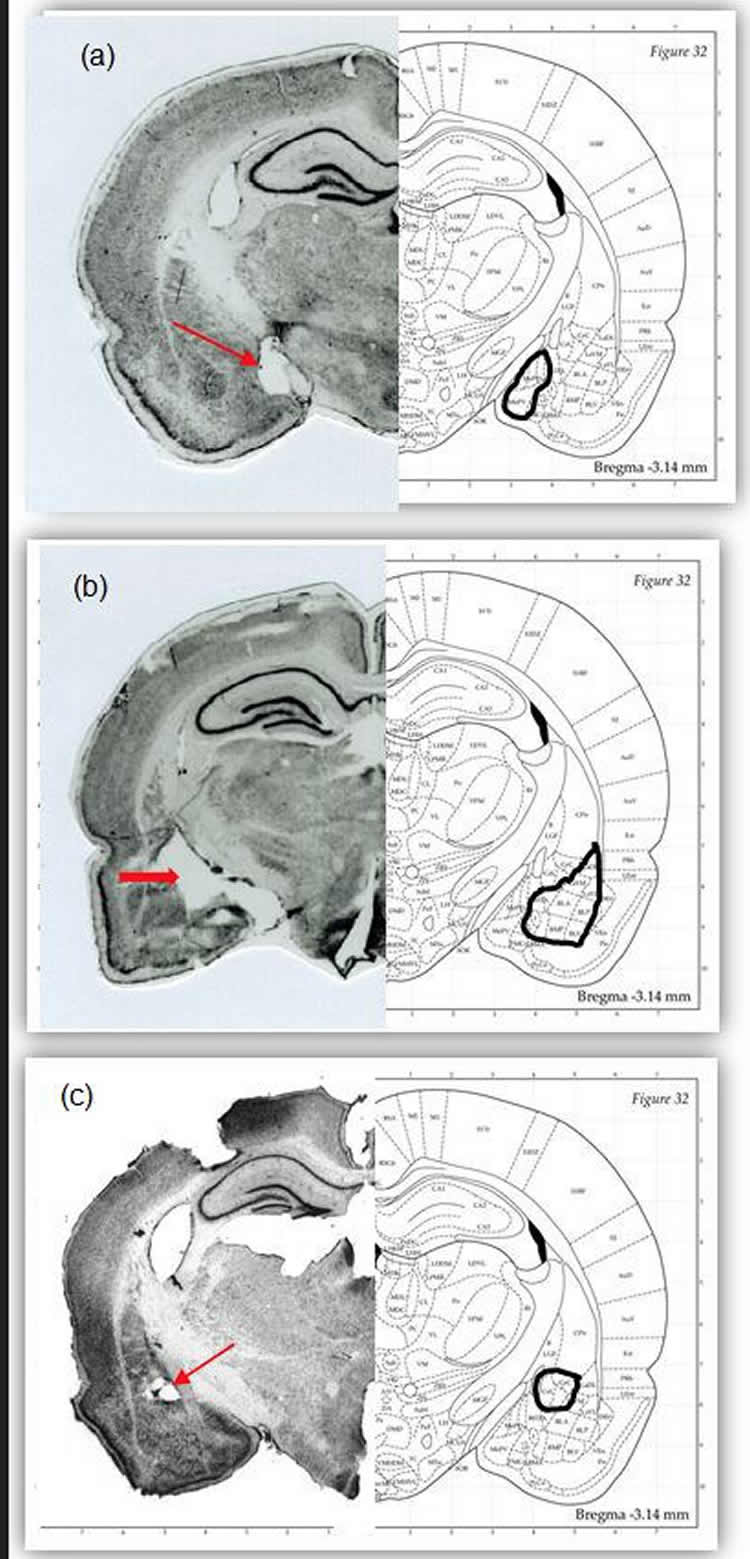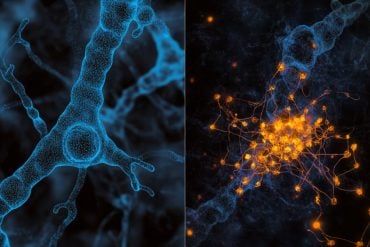Summary: A new study implicates the basolateral amygdala in conditioned taste aversion. The study could pave the way for treatments to curb taste aversions associated with chemotherapy and eating disorders.
Source: University of Granada.
Researchers from the University of Granada, together with scientists from the Autonomous University of Baja California (UABC), have identified the area of the brain that is directly involved in our aversion to toxic, spoiled or poisonous foods. The results, obtained from experiments on laboratory rats, lay the foundations for new studies on the development of taste and eating behaviours. Moreover, the study opens the door to potential therapeutic applications for the treatment of alterations that commonly occur after chemotherapy, as well as other therapies for eating disorders such as anorexia and obesity.
The rejection of foods that our brain associates with gastric toxicity and poisoning is characteristic of what experts call taste aversion learning. Its impact on eating behaviour is well documented, but the brain connections involved in each stage of the development of taste aversion are still unknown, particularly with regard to the development of taste memory and its association with stomach problems.
Building on previous studies that pointed towards the involvement of the amygdala in taste aversion, the UGR researchers focused on this small structure located in the limbic region of both hemispheres which is involved in learning and memory, as well as emotional processing.
Both vertebrates and invertebrates have the ability to recognise potentially toxic flavours, thereby avoiding poisoning. In humans, not only is this essential for survival; it can also form part of the mechanisms that lead to diverse eating disorders. The researchers describe the experiments conducted on the rats, designed to identify the area of the amygdala involved in the process of taste learning and memory associated with toxic effects, in a paper titled ‘Effects of lesions in different nuclei of the amygdala on conditioned taste aversion’, published recently in the prestigious international journal Experimental Brain Research.
The taste aversion learning model is widely used in animal research to explore learning and memory. The experiment involves exposing the animal to a new non-toxic taste and, a few minutes later, inducing gastrointestinal upset by administering an injection of a harmful substance. The animal thereby learns to associate the taste with stomach upset. This taste aversion not only induces rejection and avoidance, but also loss of appetite.
During the study, the researchers intentionally damage the three main nuclei of the amygdala to determine which region is responsible for the acquisition of conditioned taste aversion (CTA). Using this method, the researchers were able to determine the specific area that regulates the magnitude of taste aversion, called the basolateral complex.
The amygdala is part of the limbic system, a brain region associated with emotions and learning involved in negative emotional processing, such as fear and disgust, as well as in the processing of memories that contain emotions. The structure of the limbic system is composed of a series of groups of neurons including central, medial and basolateral nuclei, among others.

Of the four groups of animals under study, a reduction in aversion was only observed in the group with lesions in the basolateral complex of the amygdala. As Andrés Molero, co-author of the paper, explains: “We have confirmed that taste aversion in the group with lesions in the basolateral complex of the amygdala was reduced, in other words; although these groups also learn to reject taste, they consume higher quantities compared with the groups without lesions or with lesions in the other amygdaloid nuclei.”
Tastes to remember
Preferences for certain tastes can either be innate or learnt. If learnt, the corresponding preferences depend on whether the consequences of eating certain foods are positive (pleasure or satiety), or on the contrary, negative (discomfort or sickness). The natural response is to reject a taste when it is recognised as unpleasant or disgusting. For example, if something tastes like bleach, we are more likely to reject it.
According to the researchers, when a particular taste is accompanied by sickness attributable to the food with the taste, such as is the case with poisonous mushrooms, a conditioned taste aversion (CTA) arises following a single experience of consuming the substance. This association between taste and symptoms of poisoning also arises even if the stomach upset occurs several hours after having eaten. This is because the time needed to digest the food causes a delay in the association between the stimuli.
This peculiar ability to associate stimuli that are not related concurrently is especially important with regard to the aversions acquired during chemotherapy treatments, since the food intake is associated with nausea which is actually induced by the chemicals administered at different stages. Patients may therefore develop taste aversion, even if they have not consumed food immediately after the treatment session. “Conditioned taste aversion (CTA) may form part of the mechanisms involved in anorexia and other similar disorders, particularly if associations arise between food and discomfort, or even with negative emotions”, the author concludes.
The researchers believe other complementary studies are necessary to improve our understanding of the respective interactions between the various components of the brain mechanism involved in the acquisition of conditioned taste aversion.
Funding: The study was funded by the Spanish Ministry of Economy, Industry and Competitiveness.
Source: University of Granada
Publisher: Organized by NeuroscienceNews.com.
Image Source: NeuroscienceNews.com image is credited to University of Granada/Khakh lab.
Original Research: Abstract for “Effects of lesions in different nuclei of the amygdala on conditioned taste aversion” by Andrés Molero-Chamizo, and Guadalupe Nathzidy Rivera-Urbina in Experimental Brain Research. Published April 2018.
doi:10.1007/s00221-017-5078-1
[cbtabs][cbtab title=”MLA”]University of Granada “Researchers Identify Area of the Amygdala Involved in Taste Aversion.” NeuroscienceNews. NeuroscienceNews, 5 April 2018.
<https://neurosciencenews.com/amygdala-taste-aversion-8732/>.[/cbtab][cbtab title=”APA”]University of Granada (2018, April 5). Researchers Identify Area of the Amygdala Involved in Taste Aversion. NeuroscienceNews. Retrieved April 5, 2018 from https://neurosciencenews.com/amygdala-taste-aversion-8732/[/cbtab][cbtab title=”Chicago”]University of Granada “Researchers Identify Area of the Amygdala Involved in Taste Aversion.” https://neurosciencenews.com/amygdala-taste-aversion-8732/ (accessed April 5, 2018).[/cbtab][/cbtabs]
Abstract
Effects of lesions in different nuclei of the amygdala on conditioned taste aversion
Conditioned taste aversion (CTA) is an adaptive learning that depends on brain mechanisms not completely identified. The amygdala is one of the structures that make up these mechanisms, but the involvement of its nuclei in the acquisition of CTA is unclear. Lesion studies suggest that the basolateral complex of the amygdala, including the basolateral and lateral amygdala, could be involved in CTA. The central amygdala has also been considered as an important nucleus for the acquisition of CTA in some studies. However, to the best of our knowledge, the effect of lesions of the basolateral complex of the amygdala on the acquisition of CTA has not been directly compared with the effect of lesions of the central and medial nuclei of the amygdala. The aim of this study is to compare the effect of lesions of different nuclei of the amygdala (the central and medial amygdala and the basolateral complex) on the acquisition of taste aversion in male Wistar rats. The results indicate that lesions of the basolateral complex of the amygdala reduce the magnitude of the CTA when compared with lesions of the other nuclei and with animals without lesions. These findings suggest that the involvement of the amygdala in the acquisition of CTA seems to depend particularly on the integrity of the basolateral complex of the amygdala.






